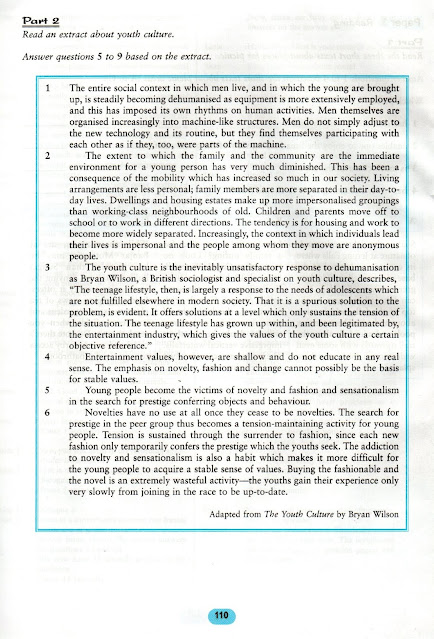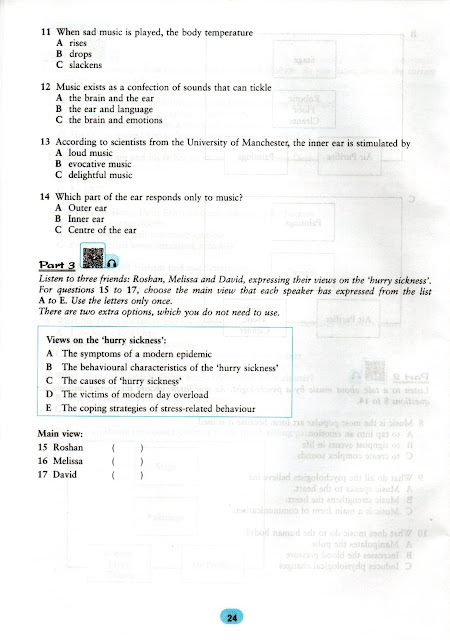Reading Comprehension ( 19 December 2024)
A one-stop MUET information station for Irshadians and Everyone! Log on and enjoy your search anytime, anywhere!
Translate
Tuesday, 17 December 2024
Wednesday, 11 December 2024
LISTENING TEST (CONTINUATION)
Listening Comprehension (continuation)
- 12 December 2024
Listen to the audio tracks and answer the questions that follow
Wednesday, 4 December 2024
LISTENING SKILL
Listening Comprehension ( 5 Dcember 2024)
Listen to the audio track
Ptactice 5, Part 1
and answer the questions that follow
Listen to the audio track
Practice 5, Part 2
and answer the questions that follow
Listen to the audio track
Practice 5, Part 3
and answer the questions that follow
Listen to the audio track
Practice 5, Part 4
and answer the questions that follow
Wednesday, 27 November 2024
Prompting - Basic in AI Classroom Instructions
How to acquire the skills in prompting?
Let' ask the chatbot
Effective prompting is crucial for getting the most out of language models. Here's a breakdown of key strategies:
1. Be Clear and Specific:
- Avoid ambiguity: Instead of "Tell me about dogs," try "Describe the characteristics of a Golden Retriever." The more specific you are, the more relevant and accurate the response.
- Provide context: If you need the model to perform a specific task, clearly outline the context and desired outcome. For example, "Write a short story about a cat who goes on an adventure, focusing on themes of friendship and courage."
2. Use Proper Formatting:
- Structure your prompt: Break down complex tasks into smaller, more manageable steps. This helps the model understand your intentions.
- Use bullet points or numbered lists: This makes your prompt easier to read and process.
- Include examples: If you want the model to follow a specific format or style, provide examples.
3. Consider the Model's Capabilities:
- Understand limitations: Not all models are created equal. Some excel at specific tasks, while others struggle. Research the model's capabilities before crafting your prompt.
- Avoid overly complex tasks: Break down complex tasks into smaller, more achievable steps.
4. Iterate and Refine:
- Experiment: Try different phrasing and structures to see what yields the best results.
- Provide feedback: Let the model know if you're satisfied with the response or if it needs improvement. This helps the model learn and improve its performance.
Example:
Ineffective Prompt: Tell me about the history of the internet.
Effective Prompt:
- Provide Context: I'm writing a research paper on the history of the internet.
- Specific Request: Can you provide a brief summary of the key milestones in the development of the internet, focusing on the period between 1969 and 1995?
- Desired Format: Please present the information in a chronological order, using bullet points.
Remember, effective prompting is an iterative process. Experiment, refine your prompts, and provide feedback to get the most out of language models.
You want to hear the chatbot talking to you? Just ask!
Wednesday, 16 October 2024
Wednesday, 9 October 2024
WRITING TASK 2
Writing Task 1 and Task 2 (10 November 2024)
Emphasis-Task 2
Task 2 - Extended writing
Sample Answer
Cellphones have become essential in life. Without them, life will be quite difficult. Most of us use cellphones to perform quite a number of tasks so sometimes we need to keep up with the technology to be at par with others. There are those who own cellphones because they are versatile or multifunctional. Some others choose to use cellphones for convenience while there are those who own them merely to follow the trend.
First, let us talk about cellphones because of the technology they are equipped with. As we know, handphones come with high end technology that can perform at high speed because of their efficient processor. Not only that, some of them come with huge storage capacity as big as 500 GB although they commonly come with 240GB storage. Apart from that, certain sets boast super amoled display screen which provides crytal clear images. In addition there are also models with foldable screens.
Undoubtedly cellphones are very versatile or multifunctional. We can use cellphones not only for calling and texting but also for taking photos, videos and perform audio recording . Certain models which come with stylus can be used for writing and drawing pad. Students and other individuals can also use cellphones for video conferencing. If one feels that he needs a calculator, he can rely on this electronic companion. In short, this ferranti has a variety of uses.
Cellphones are also convenient to use as they can perform a lot of functions. We need not carry other devices as the handsets can perform most tasks. One most important point is, they are light or portable. All cellphones can be stored anywhere; in pockets, in the purse, in the knapsacks and even in pouched belts.
In contrast, some young people own cellphones just to keep up with the fashion or trend. They will keep on switching to new models every few months. This is unwise and wasteful. Some youngsters go for the look and appearance of the phones. They are a lot of extras to woe the the buyers such as foldable screen, high definition multi-lens cameras and beutiful covers.
In conclusion, cellphones are important for their versatility and convenience. Some people own them for their excellent performance but it is undeniable that some youngsters own cellphones just to keep up with the trend.
Wednesday, 2 October 2024
Wednesday, 11 September 2024
Monday, 26 August 2024
Speaking Skills PAPER 2
Paper 2 Speaking Test (29 August 2024)
Individual (Part 1) and Group Presentation (Part 2)
Please pay attention to the ones below
Wednesday, 14 August 2024
LISTENING SKILLS
Co-user Darul Hadith Staff on 8 October 2024 for Lesson 24
Listening Comprehension (15 August 2024)
Listen to the audio track and answer the questions that follow:
Practice 3 Part 1 Audio Track
Practice 3 Part 2 Audio Track
Practice 3 Part 3 Audio Track
Practice 3 Part 4
Practice 3 Part 5
Dialogue 1
Dialogue 2
Dialogue 3
Wednesday, 7 August 2024
Writing for Task 1 and 2
AI in classrooms in China
China has really made use of AI to facilitate learning and classroom management...where are we?
China has its own internet access system?
7 August 2024
Writing a reply to an e-mail and an essay on expressing an opinion
Monday, 8 July 2024
Wednesday, 3 July 2024
Tuesday, 25 June 2024
LISTENING COMPREHENSION PART 3
Listening Comprehension Part 3 (27 June 2024)
How do you go about dealing with Listening Comprehension?
Follow these steps:
a) As soon as you receive the question paper, read through the questions the moment you are allowed to do so.
b) Look for the keywords and underline them. This will lead you to focus on the audio tracks to get the answers as soon as the tracks are played.
c) Always look at the questions (especially the keywords) while listening or you will miss the answers.
*Note that the conversation or dialoge is not arranged according to the order of the questions. So, pay attention to the audio tracks every second. Make sure your eyes and ears are all alerted or focussed to 'catch' the keywords. The words used in the question paper and the audio tracks may not be the same. So, again, watch out!
Listen to the audio tracks and follow the instructions:
Subscribe to:
Comments (Atom)



















































